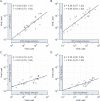Investigating the outcomes of virus coinfection within and across host species
- PMID: 37216391
- PMCID: PMC10237676
- DOI: 10.1371/journal.ppat.1011044
Investigating the outcomes of virus coinfection within and across host species
Abstract
Interactions between coinfecting pathogens have the potential to alter the course of infection and can act as a source of phenotypic variation in susceptibility between hosts. This phenotypic variation may influence the evolution of host-pathogen interactions within host species and interfere with patterns in the outcomes of infection across host species. Here, we examine experimental coinfections of two Cripaviruses-Cricket Paralysis Virus (CrPV), and Drosophila C Virus (DCV)-across a panel of 25 Drosophila melanogaster inbred lines and 47 Drosophilidae host species. We find that interactions between these viruses alter viral loads across D. melanogaster genotypes, with a ~3 fold increase in the viral load of DCV and a ~2.5 fold decrease in CrPV in coinfection compared to single infection, but we find little evidence of a host genetic basis for these effects. Across host species, we find no evidence of systematic changes in susceptibility during coinfection, with no interaction between DCV and CrPV detected in the majority of host species. These results suggest that phenotypic variation in coinfection interactions within host species can occur independently of natural host genetic variation in susceptibility, and that patterns of susceptibility across host species to single infections can be robust to the added complexity of coinfection.
Copyright: © 2023 Imrie et al. This is an open access article distributed under the terms of the Creative Commons Attribution License, which permits unrestricted use, distribution, and reproduction in any medium, provided the original author and source are credited.
Conflict of interest statement
The authors have declared that no competing interests exist.
Figures




References
-
- Loving CL, Brockmeier SL, Vincent AL, Palmer MV, Sacco RE, Nicholson TL. Influenza virus coinfection with Bordetella bronchiseptica enhances bacterial colonization and host responses exacerbating pulmonary lesions. Microb Pathogenesis. 2010;49(5):237–45. doi: 10.1016/j.micpath.2010.06.004 - DOI - PubMed
Publication types
MeSH terms
Supplementary concepts
Associated data
Grants and funding
LinkOut - more resources
Full Text Sources
Molecular Biology Databases

